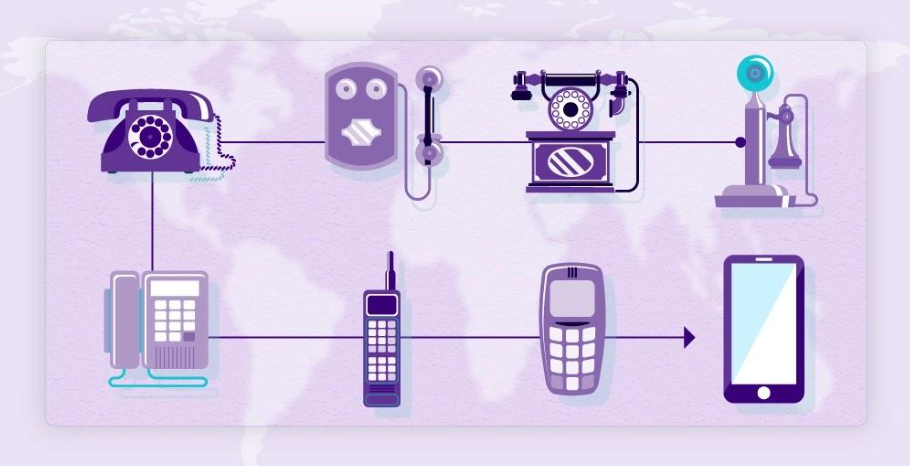Telephony has come a long way since its invention in the late 1800s. Telephony has seen a lot of transformation and has played an increasingly important role in the ever-changing communication technology landscape.
Telephony has evolved from sending voice over long distances using telegraphs and wires to being a sophisticated system including landlines, mobile phones, and VoIP phone systems (Voice over Internet Protocol).
Similarly, the evolution of telephony, high-speed internet, and video conferencing software has resulted in other advancements like virtual meetings, which have become game-changers. At this time, we can anticipate more changes in the near future. So, let’s learn about the evolution of telephony and look into the future.
Importance of Telephony in Modern Communication
-
Real-Time Voice Communication
While text-based communication has become prevalent, there are situations where nothing can replace the personal touch of a voice conversation. Telephony allows individuals to connect and communicate in real-time, enabling nuanced discussions, emotional expression, and clear clarification that text or other means alone may not convey effectively.
-
Wide Accessibility
Telephony provides a widely accessible means of communication, particularly in areas where internet access might be limited or unreliable. Traditional telephony networks can still facilitate voice calls even in remote locations or during emergencies, ensuring that individuals stay connected in crucial moments.
-
Global Connectivity
Telephony allows global connectivity, enabling individuals and businesses to communicate effortlessly across borders. International calling, roaming services, and global telephony infrastructure make it possible to connect with people worldwide, fostering global collaboration, trade, and cultural exchange.
-
Reliability and Resilience
Telephony networks, especially landline infrastructure, have proven highly reliable and resilient. During natural disasters or emergencies that disrupt internet connectivity, telephony networks often remain operational, providing critical communications lifelines.
This reliability is crucial not only for emergency services but also for public safety agencies and businesses that require uninterrupted communication.
-
Versatility and Integration
Telephony has evolved to integrate with other communication channels, such as email, messaging apps, and video conferencing. This integration allows seamless communication across various mediums, offering flexibility and convenience.
Furthermore, telephony systems can also be included with CRM Integration (customer relationship management), enabling businesses to enhance customer service and streamline communication processes.
-
Business Communication
Telephony is integral to business phone system and communication, enabling organizations to interact effectively with customers, clients, and partners. Phone calls remain preferred for sales inquiries, customer support, and negotiations.
Telephony also supports features like call forwarding, voicemail, and conference calls, enhancing collaboration and productivity within a professional setting.
The Past: Evolution of Telephony

Telephony might not have the same importance as it used due to the advancements in other commuting means like instant messaging and digital communication. However, it is still one of the most integral parts of communication to date.
From the breakthrough telephone communication with telephone lines and infrastructures to mobile phones and now Voice over Internet Protocol (VoIP), telephony has drastically changed in past decades. So, here is a snapshot of the evolution of telephony.
-
Early Telegraph Systems
The invention of the telegraph in the early 19th century laid the foundation for telephony. Samuel Morse and Charles Wheatstone developed systems in the 1830s that enabled coded electrical signals to be transmitted over wires. Even though these systems primarily sent written messages, they paved the way for future voice transmissions.
-
Telephone
Alexander Graham Bell patented the telephone in 1876, making it one of the most significant breakthroughs in the history of telephony. Bell’s invention enabled voice communication between distant points through sound transmission. This invention revolutionized communication and set the stage for the development of modern telephony systems.
-
Telephone Networks
Telephone networks began to expand rapidly after the invention of the telephone. Initially, these networks consisted of only a few lines within a region. As technology and infrastructure advanced, telephone exchanges were established, allowing connections between many subscribers.
Major cities and countries worldwide had telephone networks by the late 19th century, facilitating long-distance communication.
-
Introduction of Automatic Exchanges
A significant advancement in telephony led to automatic exchanges in the early 20th century. Previously, operators had to establish connections between telephone calls manually. With electromechanical switches, automatic exchanges allowed self-service dialing, making telephone communication more accessible and efficient.
-
Mobile Telephony
Mobile communication was introduced after the automatic exchange, making telephony more advanced. Mobile telephony systems, such as the Improved Mobile Telephone Service (IMTS) and the Advanced Mobile Phone System (AMPS), enabled voice communication on the move.
Moreover, cellular networks and commercial mobile services later enabled wireless communication, evolving telephony and overall communication.
-
Voice over Internet Protocol (VoIP) or Digital Telephony
Digital technology led to further advancements in telephony in the late 20th century. This resulted in digital telephony replacing analog telephony, significantly improving voice quality and increasing capacity.
The emergence of Voice over Internet Protocol (VoIP) technology in the late 1990s enabled voice communication to be transmitted over Internet protocols, making international calls more accessible. Business VoIP has become too common today, where communication requires topmost priority.
-
Integration of Telephony and Internet
After the rise of the Internet, telephony was quickly merged with various digital communication channels. The traditional telephone systems were integrated with internet-based platforms, enabling various means of communication like virtual meetings, email, instant messaging, and video conferencing features.
The integration of telephony also resulted in other advancements like Unified Communications (UC), where voice, video, and data can be seamlessly integrated into a unified communication experience.
Virtual meetings have become one of the most important parts of telephony’s evolution, revolutionizing communication as we know it.
The Present: Virtual Meetings and Their Impact
Virtual meetings have become integral to business communication, revolutionizing how individuals and organizations connect, collaborate, and conduct meetings.
Virtual meetings are the platforms that enable individuals to meet virtually via video conferencing, eliminating the need for physical presence in a shared location. This concept has gained immense popularity and has become a preferred method of communication for businesses worldwide.
Here is an overview of virtual meeting and their impacts on communication:
-
Cost Saving
A virtual meeting helps reduce costs and saves resources compared to traditional meetings (Face-to-face meetings). For instance, virtual meetings help in cost savings in travel expenses, accommodation, or venue rentals.
The saved resources can be allocated and used to benefit personal and business levels.
-
Enhanced Flexibility and Accessibility
Virtual meetings also offer great flexibility and accessibility as they can connect people despite their physical locations. All you need is a good internet connection and a business or cell phone device.
Whether it’s team members working remotely, clients in different time zones, or international partners, virtual meetings make it possible to connect and collaborate effortlessly, transcending geographical boundaries. These cannot be possible with traditional meetings.
-
Time Efficiency
Virtual meetings can be scheduled promptly as needed, and participants can quickly join without delays. For instance, traditional meetings might be delayed in case of the absence of participants, travel, and other similar cases.
Additionally, virtual meetings are more focused and streamlined, helping keep discussions on track and reducing unnecessary tangents, saving valuable time.
-
Interactive Communication Tools
Virtual meetings often have interactive collaboration tools like screen sharing, virtual whiteboards, and document-sharing capabilities. These tools enable real-time collaboration, allowing participants to present ideas, brainstorm, review documents, and annotate.
The interactive nature of virtual meetings enhances engagement and facilitates productive collaboration among participants.
The Future: Trends and Innovations in Virtual Meetings
Telephony, communication has already seen quite a change in recent years. So, we can anticipate more drastic changes in the coming days. Considering this, here are the most probable trends and innovations in virtual meetings.
-
Artificial Intelligence (AI)
Artificial intelligence is everywhere nowadays. AI might play a significant role in enhancing virtual meetings. For instance, AI-powered virtual assistants can automate tasks, transcribe conversations, and provide real-time language translation. They can also generate meeting summaries, identify action items, and offer intelligent suggestions to enhance productivity.
-
Augmented Reality (AR) and Virtual Reality (VR)
With the ongoing evolution and advancements, we cannot rule out the possibility of AR and VR being implemented in virtual meetings. AR and VR technologies have the potential to revolutionize virtual meetings by creating immersive and interactive experiences.
For example, participants might be able to use AR glasses or VR headsets to enter a shared virtual environment to collaborate, manipulate virtual objects, and engage in lifelike simulations. This will open a whole new level of technological advancement.
-
5G Connectivity
Many countries have started using 5G networks. So, it is only a matter of time before the virtual meeting is integrated with 5G connectivity. The rollout of 5G technology promises faster and more reliable internet connections, enabling seamless virtual meetings even in remote locations.
5G will support high-quality video streaming, real-time collaboration, and interactive communication with higher bandwidth and lower latency.
-
Integrated Collaboration Tools
There are already several collaboration tools integrated with virtual meetings. However, it seems obvious that the integration of collaboration tools within virtual meeting platforms will continue to evolve.
The potential integrated project management tools and seamless integration with other communication channels like messaging apps and email might foster efficient collaboration, making it easier for participants to share, edit, and collaborate on documents and projects during virtual meetings.
Conclusion
Telephony has undergone significant changes, enabling global connectivity and real-time voice communication. Virtual meetings have become vital tools that offer cost savings, flexibility, and streamlined collaboration.
The future of virtual meetings holds exciting possibilities with the integration of advanced technologies and the promise of faster and more reliable connectivity, paving the way for more immersive and productive communication experiences.











